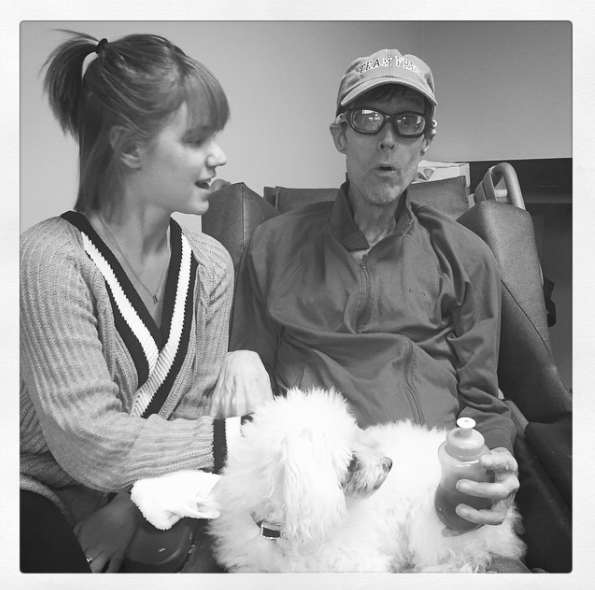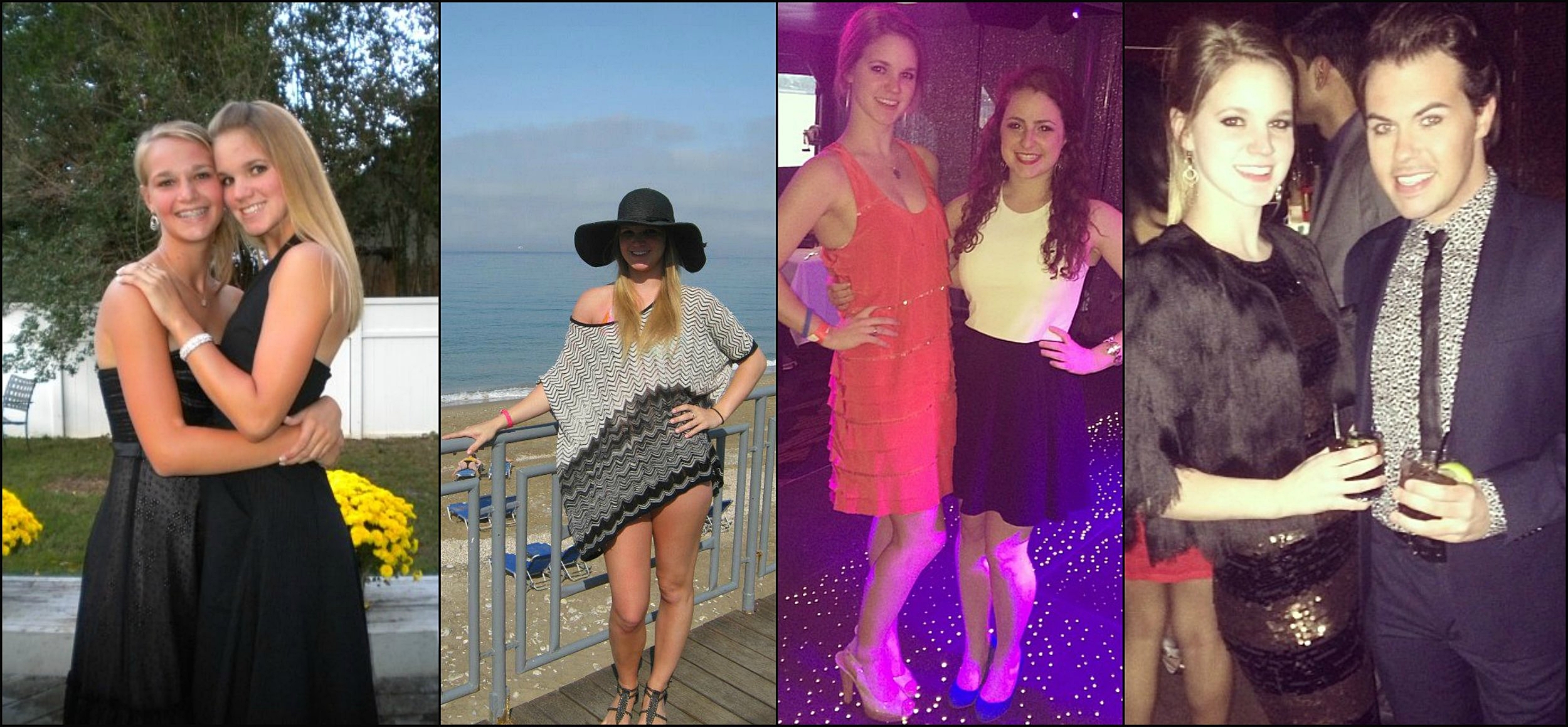From my last visit with dad.
When I first sat down to write this essay, I planned to start off on a positive note, saying, confidently, I’ve always felt hopeful about my future with Huntington’s. After all, one of the joys of being young and ambitious is having a head full of hopes and dreams. But after my dad died, hope started to feel impossible.
I’ll be the first to admit that I’m an incredibly fortunate 25-year-old woman living out my dream; writing in my favorite city surrounded by the best people. But that’s only part of my reality. The other part is my dad died of Huntington’s disease last year and my two sisters and I all have a 50/50 chance of suffering the same fate.
Since discovering my dad’s illness and how it would affect me, I’ve struggled with the whole 50/50 odds. When I’m splitting the check or getting something 50 percent off, I’m psyched – it’s easy-to-do math and a significant discount– but when it’s my life on the line, it’s not as simple. In fact, it’s one of the most complicated percentages that exists in my world.
I’ve always bounced back and forth between knowing I did or didn’t have HD. I always knew too, I never thought or suspected– I knew. There were months at a time where I knew that I didn’t have it. Every day I would think, there’s no way. My luck was not that bad. Then, one day, my tune would completely change. I’d think, ‘Of course I have it! All these other people got it, what makes me so special?’ Then when my dad died, I accepted that I wouldn’t play these back and forth games anymore. I would forever, in my mind, know that I had the Huntington’s gene. It’s hard (impossible?) to think you can beat something that so shamelessly took a person who’s supposed to protect you.
I could put this mental battle to rest and get tested so I would know with absolute certainty that I did or didn’t have HD. As simple as that sounds though, there’s so much more to it. You can’t just go into a doctor’s office and get a blood sample taken. You have to attend a set of at least three sessions, where you meet with a genetic councilor and a psychologist to ensure you are ready for the results– whatever they may be.
I’ve decided that going through all of this will not help me in any way, shape or form. No matter whether I get back negative or positive results, either will only complicate my life even more. Just think, if I do test positive, it’s like I’m signing my death warrant at 25. If I test negative, then I still have my sisters to worry about. Even though my odds don't effect theirs, I’ve always felt like if I test negative, my sisters have a likelier chance of testing positive. I know this thought process is just straight up wrong, but to me it feels real and daunting.
My reality has always been a bit blurred and skewed thanks to my 50/50 chance. Having this awareness of something so up-in-the-air influences all kinds of my decisions or feelings. Sure, no one has a 100 percent assurance on what their future health looks like, but it’s strange knowing such a definite number that sits right in the middle; not swaying one way or another, for something as serious as an incurable disease. My family isn't particularly lucky (for many reasons) and with something so in-the-middle, luck feels important if not necessary. The only thing I've ever been able to hold on to is what has happened. And what happened is my dad didn't beat it. So how could I?
* * * *
As we get older, we all begin to see our parents in ourselves. We start to see their mannerisms and habits manifest. As I approached my quarter-life mark, I began to see in me my dad’s love of music, his fascination with history and his same deteriorating end-of-life stages. Any hope I had been barely holding onto before his death, the jumping back and forth, was totally shattered that April day.
Then in December, something happened that brought back hope. Not just a speck of it either, but an overwhelming sense of it. There was a breakthrough in HD research, the biggest one since isolating the gene in 1992. Researchers studying the drug IONIS-HTTRx announced they were moving forward to the second and final part of the trial after showing promising results.
They had discovered that the drug successfully intercepts the messenger molecule and destroys it before it can create the mutant protein, huntingtin, that causes HD symptoms. Currently people with HD can only get medication to treat certain symptoms. This means the cognitive, psychological and kinetic effects of the disease still lives within the person and can resurface if medication stops. Thanks to this new drug though these symptoms are prevented before they even occur.
Unfortunately this discovery doesn’t help people who have already begun showing signs of HD. For a person at-risk like me though, it is one of the most promising things we could hear besides, "this gene doesn’t exist in your family anymore."
This news completely changed my mentality on what my life could look like. I can have any future I want without worrying about how it will affect my family or hinder my career. A year ago, I made a choice to quit my job and pursue writing full time, understanding full-well that I could lose my ability to think clearly and write before I turn 40. My dad did it all ‘right,’ conventionally speaking. He went to law school, was in the JAG and worked as a Cincinnati magistrate. All was good until he just couldn’t do it anymore thanks to the early stages of HD. Right before his diagnosis, he couldn’t even hold a job as a bag boy at the local grocery store. Thanks to this new drug though, there’s a possibility that I can stop this devastating decline before it ever even happens. It has given me a chance to live my life like everyone else, without the weight of a devastating future dictating my decisions.
Before this announcement, the only thing I could really cling on to was the thought that I simply do not carry the gene. Now there’s actual options if I do test positive. Even more significant, there’s options if my sisters are positive. Now, no matter whether one of us or all three of us have it, we can treat and fight it if we need to. My family may not be lucky, but we are all fighters.
The word “incurable” inevitably feels hopeless. Now the at-risk community has actual tangible science we can hold on to for the hope we deserve. This breakthrough gives me and others in my position a shot at a full life. If I do have the gene, I can tackle it head on and fight it the same way anyone else does other illnesses. It’s no cure, but it’s pretty damn close.
So grateful for my amazing and supportive friends (family?) .
I’m so grateful that this discovery happened when it did. It came at a point in my life when I’ve never felt more aware of my own immortality. By no means does this drug make me feel immortal, but it has brought back a feeling of aspiration that I thought was lost forever. Now I have the opportunity to be like any 25-year-old; Figuring life out and stumbling along the way. Now I don’t have to take these falls so hard anymore, thinking I’m wasting precious time I don’t have. I can enjoy my complicated journey and make the much-needed mistakes that happen along the way.
No longer will hopelessness dictate how I feel or what I choose to do. Thanks to this discovery, I will dictate how I feel and what I do with my life– and nothing can stop me.






